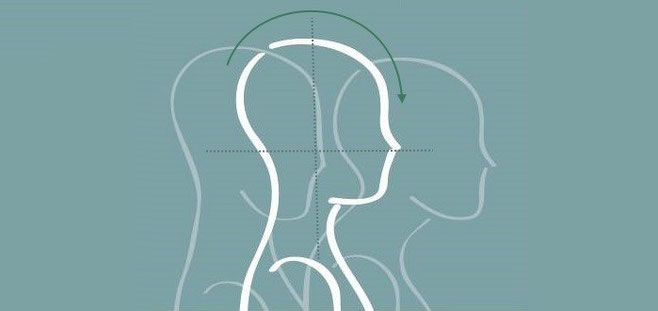Hopefully I convinced you in my last blog that the Alexander Technique is the logical solution to the aches and pains you experience during your working day. Over the next series of blogs I want to share with you some insights on how you can improve your situation.
There's a preoccupation with the relationship between the head and neck/spine in the Alexander Technique, and for good reason, your head is heavy, really heavy! The head can weigh up to 11lbs or 5Kg, think 5 bags of sugar or a bowling ball. It's not something you want to be holding up with the muscles of your neck, upper back and shoulders. Thankfully you don't need to if it's balanced on top of your spine well, thinking of your neck as part of your spine as a whole rather than a separate entity.
The head balances on the spine much higher up than many people realise, if you point your fingers right below your earlobes, in line with the bottom of the nose, that's the axis around which the head articulates with the spine to allow it to nod forward and back. Shaking the head from side to side happens between the first two vertebra so could be said to be a spine movement rather than a head movement.

As it happens, there's slightly more of your head (including the lower jaw) in front of the atlas joint (where the skull meets the spine) than behind it, so gravity will naturally cause the head to roll forward so that your nose bobs downwards, as long as you are not tensing your neck muscles. This is great as it also means that with the head rolling forward the muscles of your neck and back will be gently lengthened if you allow them to let go. Don't worry, your head wont fall off, you don't need to hold it there in place. So instead of fighting gravity, let it help you. One thing to remember though is that although it's great to let your head roll forward, you don't want to allow your neck to poke forward too, your neck wants to stay back as a lengthening integrated part of the whole spine.
It's interesting that many osteopaths, chiropractors and physios talk about the "head forward syndrome/posture" when in reality it is the neck that is going forward whilst the head would be going
back and down. To counteract this Alexander famously reminded himself with the phrase "head forward and up" as a prevention to pulling his head back and down.
Now, in reality , you may not actually spend all your time in this neutral position, as I like to think of it. You are free to look up and around, and move your neck and spine this way and that, but the question is, can you freely return to neutral, and do you kinaesthetically even know where it is? This is something that the Alexander Technique really helps with, it fine tunes your awareness of yourself and your orientation to the space around you. But it's not just where your head is physically, put also mentally, but more on that in my next blog ...
Please feel free to contact me for a no obligation chat to see how the Alexander Technique can help you too.

Write a comment
Marja Bennett (Friday, 03 October 2014 13:37)
Very nice Adrian. And love the song!
adrianfarrell (Friday, 03 October 2014 13:42)
Thanks Marja, next time I'll try and shoehorn some Zeppelin in ;)
Victoria Stanham (Friday, 03 October 2014 21:00)
Nice one!
You're right, it's called a "head-forward" syndrome when actually, it's a head-back syndrome.